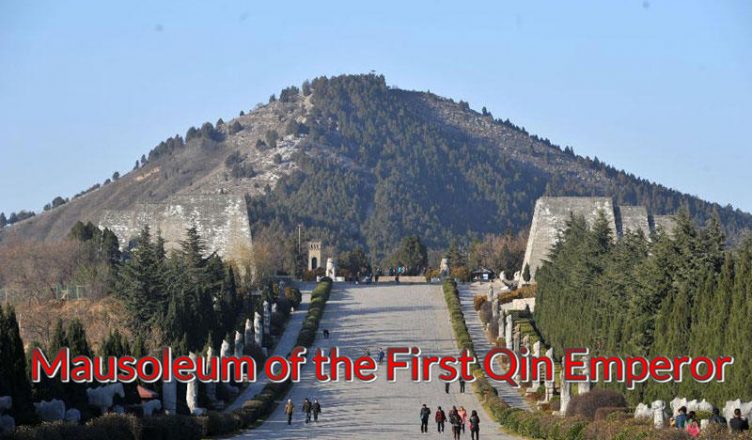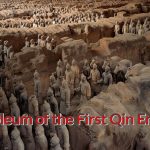The Mausoleum of the First Qin Emperor, located in Xi’an, Shaanxi Province, China, is historically known as “Lishan Yuan.” It is the burial site of Qin Shi Huang, the first emperor of China. The specific location of the Mausoleum is at the northern foothills of Mount Lishan, east of Lintong District in Xi’an, Shaanxi Province. It is situated with Mount Lishan to the south, the Wei River to the north, extending from Chenjiayao Village at the foot of Mount Lishan to Wudong and Wuzhong villages in the north, from the eastern wall of the Sand Wheel Factory in Xi’an to Daiwang Town in the east. The Mausoleum covers an area of 56.25 square kilometers, spanning 7.5 kilometers in both east-west and north-south directions.
The Mausoleum of the First Qin Emperor is oriented from west to east, and its layout imitates the design of the Qin capital, Xianyang. It can be divided into four levels with the burial mound at the center: the underground palace city (burial chamber) as the core, followed by the inner city, outer city, and the area beyond the outer city. The inner city has a perimeter of approximately 2.5 kilometers, while the outer city has a perimeter of around 6.3 kilometers. Beyond the outer city lies a large burial pit for accompanying artifacts, with the famous Terracotta Army pit located on the eastern side of the Mausoleum, outside the outer city.
The concept of the Mausoleum of the First Qin Emperor as a “tomb city” and the “imperial mausoleum system” reflects the idea that the imperial mausoleum and the capital city serve as symbols of the centralized feudal empire. Influenced by this concept and system, starting from the Mausoleum of the First Qin Emperor, imperial tombs not only became more grandiose in scale but also broke away from the centralized public cemetery system of the Shang and Zhou periods. Instead, it established an independent tomb complex development model that persisted through the Ming and Qing dynasties.
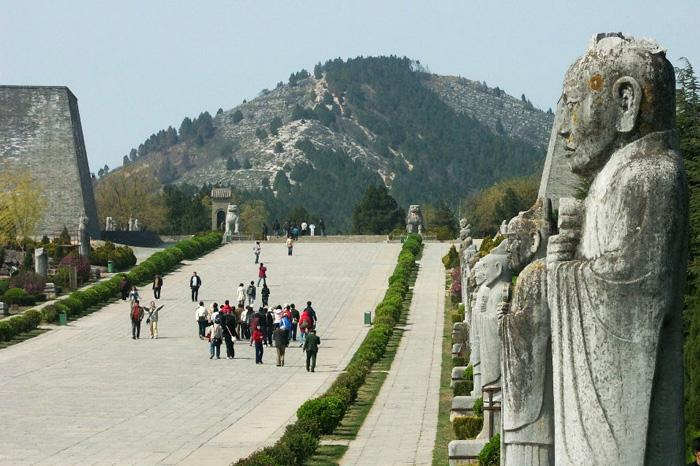
In 1961, the Mausoleum of the First Qin Emperor became one of the first national key cultural heritage protection units. In 1987, it was inscribed on the UNESCO World Heritage List, and it is recognized as a national 5A-level scenic area in China.
Geographical Environment
The Mausoleum of the First Qin Emperor is currently situated at the northern foothills of Mount Lishan, east of Lintong District in Xi’an, Shaanxi Province, China. It is bordered to the south by Mount Lishan and to the north by the Wei River, forming a “回” (Hui) shaped pattern with a narrow eastern section and a longer western section. The area extends from Chenjiayao Village at the foot of Mount Lishan in the south to Wudong and Wuzhong villages in the north, from Daiwang Town in the east to the eastern wall of the Sand Wheel Factory in Xi’an to the west. The Mausoleum covers an area of 56.25 square kilometers. Despite Qin Shi Huang governing from the capital Xianyang, the burial site was chosen far from Xianyang, in the shadow of Mount Lishan.
The geographical attributes of the Mausoleum of the First Qin Emperor fall within the warm temperate zone, with a semi-humid monsoon climate. The average annual temperature ranges from approximately 12 to 13.6 degrees Celsius, with an annual rainfall of about 500 to 800 millimeters, concentrated mainly from July to September. The region experiences distinct seasons, with long durations of both winter and summer. Spring and autumn see rapid temperature changes, while summers are often dry, and autumns bring frequent overcast and rainy days.
Construction Background
Purpose of Construction
The Mausoleum of the First Qin Emperor serves as the imperial tomb for Emperor Qin Shi Huang. Born in 259 BC and passing away in 210 BC, Qin Shi Huang ascended the throne at the age of 13, underwent a coronation ceremony, and at the age of 39, completed the grand unification of the realm. He pioneered the first centralized feudal state in Chinese history, establishing a centralized authority in the multi-ethnic Qin state.
Choice of Location
Location: In the Shadow of Mount Lishan
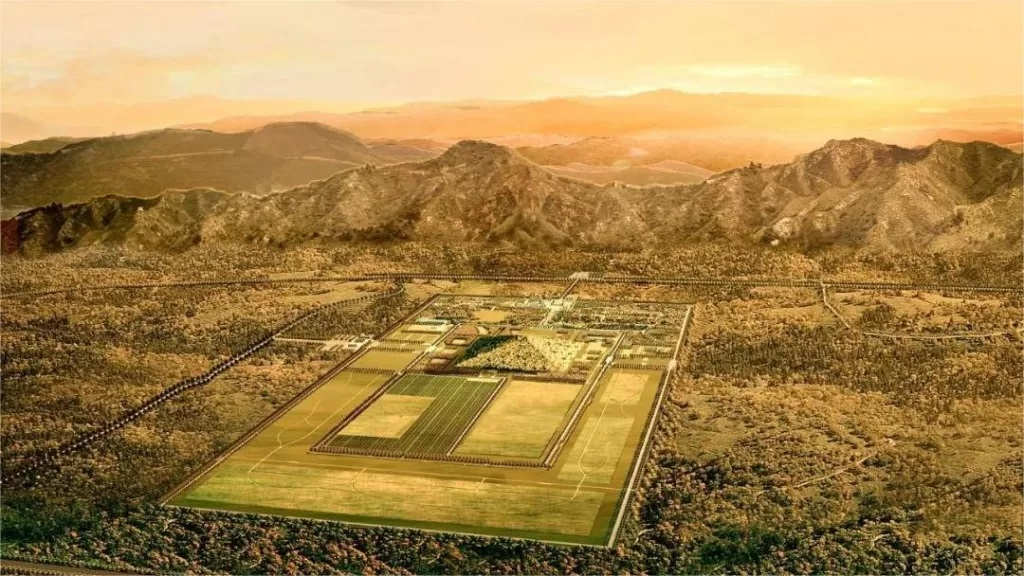
Speculated Reasons for Location:
1: During the era of Qin Shi Huang, inspired by traditional Chinese thought of “burial sites near mountains and water,” there was a man-made fish pond on the east side of the Mausoleum. The Northern Wei Dynasty’s Li Daoyuan recorded in the “Water Classic Commentary”: “The water flows and turns eastward, then stays northward, and Qin Shi Huang built his tomb, taking soil from this deep place, and the accumulated water formed a pond, called the Fish Pond… the water in the pond flows northwest, passing through the north of Qin Shi Huang’s tomb.”
2: Some scholars speculate that the choice of the burial site is related to the natural geological conditions. However, the natural environment and geological conditions of the site are not conducive to a rational layout of the tomb. The southern part of the burial site has high and low terrains formed by the mountain stream at the mouth of Lishan. During heavy rainfall, flash floods may occur, creating multiple channels that could negatively impact the construction of the burial site. Additionally, the northern side of Mount Lishan has numerous fractures and tilted layers, with limestone nodules and loess layers in the foothills. Despite these limitations and challenges, Qin Shi Huang vigorously advocated for the construction of the Mausoleum at this location and carefully planned its design.
Construction Process
The Mausoleum of the First Qin Emperor was primarily designed by Prime Minister Li Si, and the overall construction was supervised by the military general Zhang Han. The construction involved the recruitment of around 70,000 individuals initially, but at its peak, the workforce exceeded 700,000, resulting in massive human resource consumption.
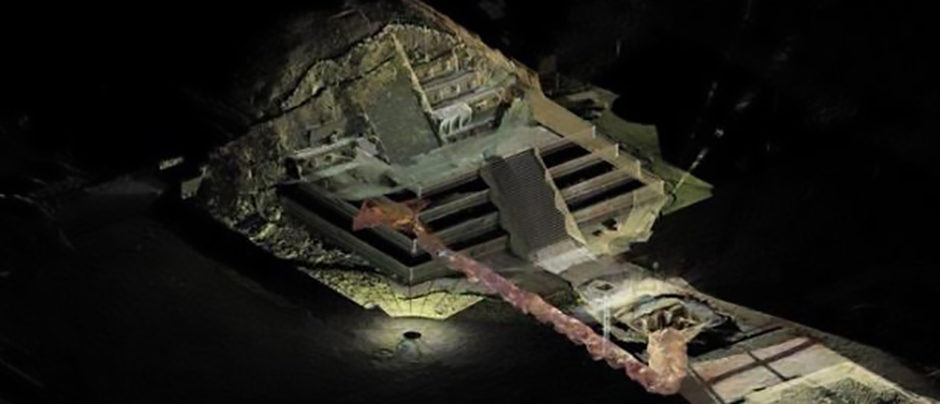
The construction of the Mausoleum of the First Qin Emperor spanned a total of 39 years. The project was not completed by the time Emperor Qin Shi Huang passed away. After his death, it took over a year, during the reign of the second emperor, to finalize the construction. The entire construction process can be divided into three periods.
Early Construction: Spanning six years during Emperor Qin Shi Huang’s unification of the country, this initial phase laid the groundwork for the mausoleum’s size and scale. It involved the preliminary design of the mausoleum and the subsequent implementation of its main construction.
Mid-term Construction: Over the 35 years of Emperor Qin Shi Huang’s reign, a period of nine years was dedicated to the large-scale construction of the mausoleum, representing the phase with the greatest consumption of manpower and resources. Approximately 70,000 prisoners were involved in the extensive construction, and, in general, most of the work was completed during this mid-term period.
Late-stage Construction: From the age of 35 to the winter of the first year of the second emperor’s rule, it took more than three years to complete the finishing touches. However, an uprising led by Chen Sheng and Wu Guang occurred during this time, posing a threat to the Western Qin. General Zhang Han advised the emperor Hu Hai, saying, “Bandits are approaching, and the area near the county is not enough. There is a man from Gaoshan who can be pardoned, armed, and sent to attack them.” The emperor approved the suggestion, and the rebel army was defeated. This incident, however, led to the hasty completion of the unfinished construction.
Historical Status
In the first year of Qin Ziying (206 BC), after Xiang Yu invaded Guanzhong, the Mausoleum of the First Qin Emperor suffered extensive destruction, with above-ground structures being destroyed in an instant, and the imperial tomb was excavated. After Liu Bang defeated Xiang Yu, established the capital in Chang’an, and founded the Western Han dynasty, he ordered the protection of the Mausoleum of the First Qin Emperor to gain the support of the people. Twenty households were settled near the Qin Mausoleum to serve as caretakers. Subsequent rulers of different dynasties also issued orders to protect the tombs of Qin emperors. However, the tranquility of the Qin Mausoleum did not last.
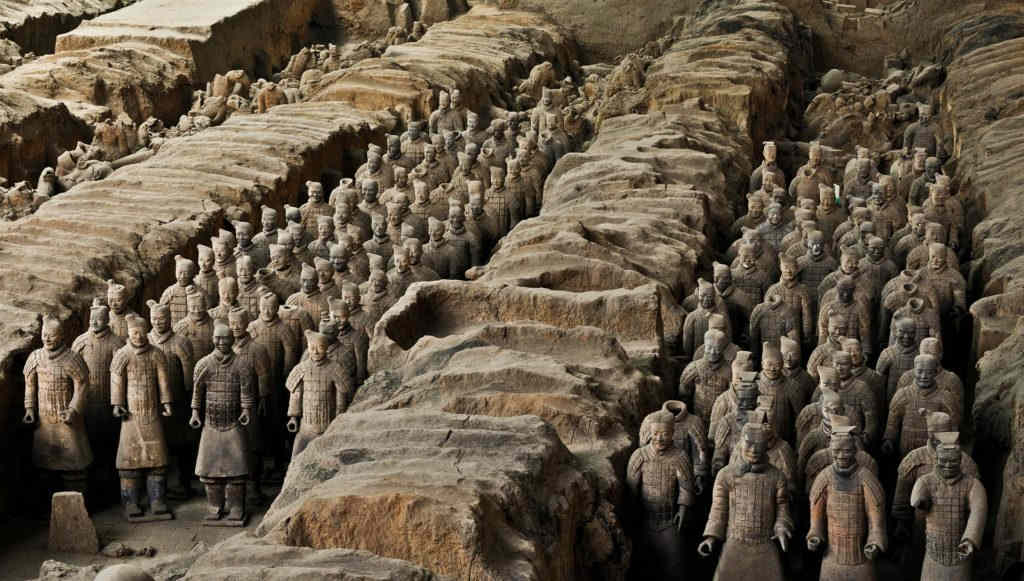
In the first year of the Eastern Han dynasty (195 BC), a child herding sheep near the Qin Mausoleum accidentally entered the underground palace while trying to retrieve a lost sheep. This led to a fire that burned Emperor Qin Shi Huang’s coffin. Historical records suggest that the fire continued for ninety days. Throughout history, the Mausoleum of the First Qin Emperor faced repeated incidents of tomb robbery. At the end of the Xin Dynasty, the Red Eyebrows rebels looted the Mausoleum, melting down burial items and the bronze coffin for copper. During the Wei and Jin periods, the ruler Shi Hu of the Later Zhao also engaged in tomb robbery at the Qin Mausoleum. In the late Tang Dynasty, Huang Chao invaded Guanzhong, causing significant damage to the Mausoleum of the First Qin Emperor. However, the accounts of Huang Chao’s theft of the Qin Mausoleum vary in different historical records, leading to skepticism. In the Five Dynasties period, General Wen Tao, under the pretext of raising military funds, extensively looted the Mausoleum of the First Qin Emperor. In the third year of the Kaibao era (970 AD) in the Song Dynasty, an order was issued to protect and repair the Mausoleum. During the Qing Dynasty, the governor of Shaanxi, Bi Yuan, erected a monument for the Mausoleum of the First Qin Emperor. In the late Qing period, tomb raiders targeted the Mausoleum once again, prompting local authorities to conduct investigations and implement protective measures. In the early years of the Republic of China, amidst warlord conflicts, Shaanxi warlords once again looted the Qin Mausoleum. Liu Zhenhua, a warlord from Henan, engaged in tomb robbery during his governance of Shaanxi. Apart from Liu Zhenhua, General Sun Lianzhong, a senior general in the National Revolutionary Army, also participated in the looting of the Qin Mausoleum during his administration.
END:
The Mausoleum of the First Qin Emperor, located in Xi’an, Shaanxi Province, is the burial site of China’s first emperor, Qin Shi Huang. Designed by Prime Minister Li Si and constructed under the supervision of General Zhang Han, the mausoleum sits at the northern foothills of Mount Lishan, displaying a monumental architectural feat. The construction spanned 39 years, divided into early, mid, and late stages, involving a massive workforce that peaked at over 700,000 individuals. Despite facing historical destruction and tomb robbery, it has received protection from various rulers over the centuries.
Impact on Posterity:
- Cultural and Historical Heritage: The Mausoleum represents the grandeur and solemnity of ancient Chinese imperial tombs, contributing to China’s historical and cultural legacy. Its architectural style and scale have influenced subsequent tomb constructions and have left a profound mark on traditional Chinese architecture and art.
- Centralized Authority System: The Mausoleum embodies the centralized authority and imperial tomb system of the Qin Shi Huang era, symbolizing national unity and centralized power. This ideology has continued to influence the construction and layout of imperial tombs throughout Chinese history.
- Archaeology and Research: The Mausoleum of the First Qin Emperor is a valuable resource for archaeological research, with significant findings, including numerous precious artifacts and the famous Terracotta Army. These discoveries contribute richly to the study of ancient Chinese history, culture, and society.
- Awareness of Cultural Heritage Protection: Enduring instances of destruction and tomb robbery have prompted an increased awareness of cultural heritage protection. Various rulers’ protective measures over time reflect an evolving understanding of the importance of preserving historical artifacts.
- Tourism and Education: As one of China’s prominent tourist destinations, the Mausoleum attracts a large number of domestic and international visitors. This influx fosters a greater understanding of Chinese history and culture, contributing to local economic development.
In conclusion, the Mausoleum of the First Qin Emperor, as a colossal historical project and a symbol of cultural and historical significance, has far-reaching implications for cultural inheritance, historical research, and the protection of cultural heritage for future generations.
More UFOs and mysterious files, please check out our YouTube channel: MysFiles
Mysterious Stone Spheres around the world – Costa Rica, European forest, Russia, Kazakhstan
